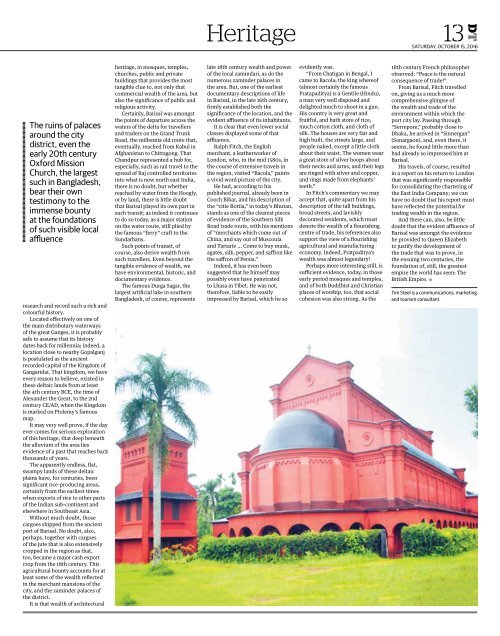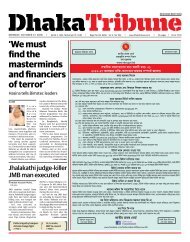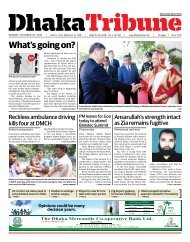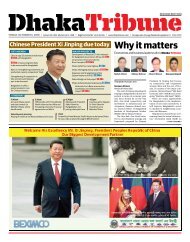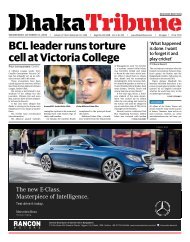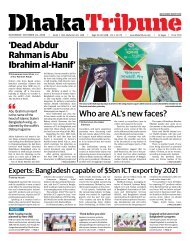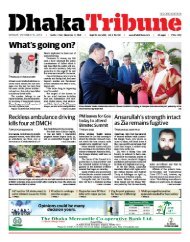DT e-Paper, Saturday, October 15, 2016
Create successful ePaper yourself
Turn your PDF publications into a flip-book with our unique Google optimized e-Paper software.
Heritage<br />
13<br />
SATURDAY, OCTOBER <strong>15</strong>, <strong>2016</strong><br />
<strong>DT</strong><br />
The ruins of palaces<br />
around the city<br />
district, even the<br />
early 20th century<br />
Oxford Mission<br />
Church, the largest<br />
such in Bangladesh,<br />
bear their own<br />
testimony to the<br />
immense bounty<br />
at the foundations<br />
of such visible local<br />
affluence<br />
research and record such a rich and<br />
colourful history.<br />
Located effectively on one of<br />
the main distributary waterways<br />
of the great Ganges, it is probably<br />
safe to assume that its history<br />
dates back for millennia; indeed, a<br />
location close to nearby Gopalganj<br />
is postulated as the ancient<br />
recorded capital of the Kingdom of<br />
Gangaridai. That kingdom, we have<br />
every reason to believe, existed in<br />
these deltaic lands from at least<br />
the 4th century BCE, the time of<br />
Alexander the Great, to the 2nd<br />
century CE/AD, when the Kingdom<br />
is marked on Ptolemy’s famous<br />
map.<br />
It may very well prove, if the day<br />
ever comes for serious exploration<br />
of this heritage, that deep beneath<br />
the alluvium of the area lies<br />
evidence of a past that reaches back<br />
thousands of years.<br />
The apparently endless, flat,<br />
swampy lands of these deltaic<br />
plains have, for centuries, been<br />
significant rice-producing areas,<br />
certainly from the earliest times<br />
when exports of rice to other parts<br />
of the Indian sub-continent and<br />
elsewhere in Southeast Asia.<br />
Without much doubt, those<br />
cargoes shipped from the ancient<br />
port of Barisal. No doubt, also,<br />
perhaps, together with cargoes<br />
of the jute that is also extensively<br />
cropped in the region as that,<br />
too, became a major cash export<br />
crop from the 18th century. This<br />
agricultural bounty accounts for at<br />
least some of the wealth reflected<br />
in the merchant mansions of the<br />
city, and the zaminder palaces of<br />
the district.<br />
It is that wealth of architectural<br />
heritage, in mosques, temples,<br />
churches, public and private<br />
buildings that provides the most<br />
tangible clue to, not only that<br />
commercial wealth of the area, but<br />
also the significance of public and<br />
religious activity.<br />
Certainly, Barisal was amongst<br />
the points of departure across the<br />
waters of the delta for travellers<br />
and traders on the Grand Trunk<br />
Road, the millennia old route that,<br />
eventually, reached from Kabul in<br />
Afghanistan to Chittagong. That<br />
Chandpur represented a hub for,<br />
especially, such as rail travel to the<br />
spread of Raj controlled territories<br />
into what is now north east India,<br />
there is no doubt, but whether<br />
reached by water from the Hoogly,<br />
or by land, there is little doubt<br />
that Barisal played its own part in<br />
such transit; as indeed it continues<br />
to do so today, as a major station<br />
on the water route, still plied by<br />
the famous “ferry” craft to the<br />
Sundarbans.<br />
Such points of transit, of<br />
course, also derive wealth from<br />
such travellers. Even beyond the<br />
tangible evidence of wealth, we<br />
have environmental, historic, and<br />
documentary evidence.<br />
The famous Durga Sagar, the<br />
largest artificial lake in southern<br />
Bangladesh, of course, represents<br />
late 18th century wealth and power<br />
of the local zamindari, as do the<br />
numerous zaminder palaces in<br />
the area. But, one of the earliest<br />
documentary descriptions of life<br />
in Barisal, in the late 16th century,<br />
firmly established both the<br />
significance of the location, and the<br />
evident affluence of its inhabitants.<br />
It is clear that even lower social<br />
classes displayed some of that<br />
affluence.<br />
Ralph Fitch, the English<br />
merchant, a leatherworker of<br />
London, who, in the mid <strong>15</strong>80s, in<br />
the course of extensive travels in<br />
the region, visited “Bacola,” paints<br />
a vivid word picture of the city.<br />
He had, according to his<br />
published journal, already been in<br />
Cooch Bihar, and his description of<br />
the “citie Bottia,” in today’s Bhutan,<br />
stands as one of the clearest pieces<br />
of evidence of the Southern Silk<br />
Road trade route, with his mentions<br />
of “merchants which come out of<br />
China, and say out of Muscouia<br />
and Tartarie ... Come to buy musk,<br />
agates, silk, pepper, and saffron like<br />
the saffron of Persia.”<br />
Indeed, it has even been<br />
suggested that he himself may<br />
possibly even have penetrated<br />
to Lhasa in Tibet. He was not,<br />
therefore, liable to be easily<br />
impressed by Barisal, which he so<br />
evidently was.<br />
“From Chatigan in Bengal, I<br />
came to Bacola; the king whereof<br />
(almost certainly the famous<br />
Pratapaditya) is a Gentile (Hindu),<br />
a man very well disposed and<br />
delighted much to shoot in a gun.<br />
His country is very great and<br />
fruitful, and hath store of rice,<br />
much cotton cloth, and cloth of<br />
silk. The houses are very fair and<br />
high built, the streets large, and<br />
people naked, except a little cloth<br />
about their waist. The women wear<br />
a great store of silver hoops about<br />
their necks and arms, and their legs<br />
are ringed with silver and copper,<br />
and rings made from elephants’<br />
teeth.”<br />
In Fitch’s commentary we may<br />
accept that, quite apart from his<br />
description of the tall buildings,<br />
broad streets, and lavishly<br />
decorated residents, which must<br />
denote the wealth of a flourishing<br />
centre of trade, his references also<br />
support the view of a flourishing<br />
agricultural and manufacturing<br />
economy. Indeed, Pratpaditya’s<br />
wealth was almost legendary!<br />
Perhaps more interesting still, is<br />
sufficient evidence, today, in those<br />
early period mosques and temples,<br />
and of both Buddhist and Christian<br />
places of worship, too, that social<br />
cohesion was also strong. As the<br />
18th century French philosopher<br />
observed: “Peace is the natural<br />
consequence of trade!”<br />
From Barisal, Fitch travelled<br />
on, giving us a much more<br />
comprehensive glimpse of<br />
the wealth and trade of the<br />
environment within which the<br />
port city lay. Passing through<br />
“Serrepore,” probably close to<br />
Dhaka, he arrived in “Sinnergan”<br />
(Sonargaon), and, even there, it<br />
seems, he found little more than<br />
had already so impressed him at<br />
Barisal.<br />
His travels, of course, resulted<br />
in a report on his return to London<br />
that was significantly responsible<br />
for consolidating the chartering of<br />
the East India Company; we can<br />
have no doubt that his report must<br />
have reflected the potential for<br />
trading wealth in the region.<br />
And there can, also, be little<br />
doubt that the evident affluence of<br />
Barisal was amongst the evidence<br />
he provided to Queen Elizabeth<br />
to justify the development of<br />
the trade that was to prove, in<br />
the ensuing two centuries, the<br />
foundation of, still, the greatest<br />
empire the world has seen: The<br />
British Empire. •<br />
Tim Steel is a communications, marketing<br />
and tourism consultant.


